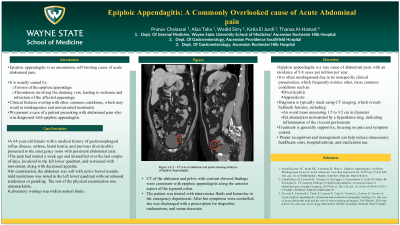Sunday Poster Session
Category: Colon
P0328 - Epiploic Appendagitis: A Commonly Overlooked Cause of Acute Abdominal Pain
Sunday, October 27, 2024
3:30 PM - 7:00 PM ET
Location: Exhibit Hall E

Has Audio
- PC
Pranav Chalasani, MD
Wayne State University School of Medicine / Ascension Providence Rochester Hospital
Rochester, MI
Presenting Author(s)
Pranav Chalasani, MD1, Alaa Taha, MD1, Wadid Sirry, MD1, Katia El-Jurdi, MD2, Thanaaa Al-hamad, MD3
1Wayne State University School of Medicine / Ascension Providence Rochester Hospital, Rochester, MI; 2Ascension Providence Hospital, Southfield, MI; 3Ascension Providence, Rochester Hills, MI
Introduction: Epiploic appendagitis is an uncommon, self-limiting cause of acute abdominal pain. It is usually caused by torsion of the epiploic appendage, or thrombosis involving the draining vein leading to ischemia and infarction of the affected appendage. Its clinical features overlap with other common conditions which may result in misdiagnoses and unwarranted treatments. We present a case of a patient presenting with abdominal pain who was diagnosed with epiploic appendagitis.
Case Description/Methods: A 64-year-old female with a pertinent medical history of gastroesophageal reflux disease, asthma, hiatal hernia, and a previous history of diverticulitis presented to the emergency room for persistent abdominal pain. The pain had surfaced about a week ago but had intensified over the preceding couple of days. The pain was localized in the left lower quadrant, with exacerbation upon movement and associated with decreased appetite. She denied fevers, nausea or vomiting, melena or hematochezia. On abdominal examination, the abdomen was soft with active bowel sounds throughout, mild tenderness was noted in the left lower abdominal region, without rebound tenderness or guarding. The rest of the physical examination was unremarkable. Laboratory workup was within normal limits. Computer tomography (CT) of the abdomen and pelvis with contrast revealed diverticula along the descending and sigmoid colon with no definite evidence of diverticulitis. However, there were findings compatible with epiploic appendagitis along the anterior aspect of the sigmoid colon. The patient received intravenous fluids, and ketorolac in the emergency department and was subsequently discharged after her symptoms were controlled. The patient was prescribed ibuprofen, ondansetron, and senna-docusate on discharge.
Discussion: Epiploic appendagitis is a rare cause of abdominal pain with a reported occurrence rate of 8.8 cases per million per year. It is often misdiagnosed due to its nonspecific clinical presentation, frequently mimicking more common conditions such as diverticulitis or appendicitis. Diagnosis is usually done with hallmark CT findings, a 1.5 to 3.5 cm in diameter ovoid mass with fat attenuation, surrounded by a hyperdense ring indicating inflammation of the visceral peritoneum. Treatment is usually supportive with pain and other symptom control. Appropriate recognition and management of this condition can reduce unnecessary healthcare costs, hospitalizations, and medication use.
Disclosures:
Pranav Chalasani, MD1, Alaa Taha, MD1, Wadid Sirry, MD1, Katia El-Jurdi, MD2, Thanaaa Al-hamad, MD3. P0328 - Epiploic Appendagitis: A Commonly Overlooked Cause of Acute Abdominal Pain, ACG 2024 Annual Scientific Meeting Abstracts. Philadelphia, PA: American College of Gastroenterology.
1Wayne State University School of Medicine / Ascension Providence Rochester Hospital, Rochester, MI; 2Ascension Providence Hospital, Southfield, MI; 3Ascension Providence, Rochester Hills, MI
Introduction: Epiploic appendagitis is an uncommon, self-limiting cause of acute abdominal pain. It is usually caused by torsion of the epiploic appendage, or thrombosis involving the draining vein leading to ischemia and infarction of the affected appendage. Its clinical features overlap with other common conditions which may result in misdiagnoses and unwarranted treatments. We present a case of a patient presenting with abdominal pain who was diagnosed with epiploic appendagitis.
Case Description/Methods: A 64-year-old female with a pertinent medical history of gastroesophageal reflux disease, asthma, hiatal hernia, and a previous history of diverticulitis presented to the emergency room for persistent abdominal pain. The pain had surfaced about a week ago but had intensified over the preceding couple of days. The pain was localized in the left lower quadrant, with exacerbation upon movement and associated with decreased appetite. She denied fevers, nausea or vomiting, melena or hematochezia. On abdominal examination, the abdomen was soft with active bowel sounds throughout, mild tenderness was noted in the left lower abdominal region, without rebound tenderness or guarding. The rest of the physical examination was unremarkable. Laboratory workup was within normal limits. Computer tomography (CT) of the abdomen and pelvis with contrast revealed diverticula along the descending and sigmoid colon with no definite evidence of diverticulitis. However, there were findings compatible with epiploic appendagitis along the anterior aspect of the sigmoid colon. The patient received intravenous fluids, and ketorolac in the emergency department and was subsequently discharged after her symptoms were controlled. The patient was prescribed ibuprofen, ondansetron, and senna-docusate on discharge.
Discussion: Epiploic appendagitis is a rare cause of abdominal pain with a reported occurrence rate of 8.8 cases per million per year. It is often misdiagnosed due to its nonspecific clinical presentation, frequently mimicking more common conditions such as diverticulitis or appendicitis. Diagnosis is usually done with hallmark CT findings, a 1.5 to 3.5 cm in diameter ovoid mass with fat attenuation, surrounded by a hyperdense ring indicating inflammation of the visceral peritoneum. Treatment is usually supportive with pain and other symptom control. Appropriate recognition and management of this condition can reduce unnecessary healthcare costs, hospitalizations, and medication use.
Disclosures:
Pranav Chalasani indicated no relevant financial relationships.
Alaa Taha indicated no relevant financial relationships.
Wadid Sirry indicated no relevant financial relationships.
Katia El-Jurdi indicated no relevant financial relationships.
Thanaaa Al-hamad indicated no relevant financial relationships.
Pranav Chalasani, MD1, Alaa Taha, MD1, Wadid Sirry, MD1, Katia El-Jurdi, MD2, Thanaaa Al-hamad, MD3. P0328 - Epiploic Appendagitis: A Commonly Overlooked Cause of Acute Abdominal Pain, ACG 2024 Annual Scientific Meeting Abstracts. Philadelphia, PA: American College of Gastroenterology.
